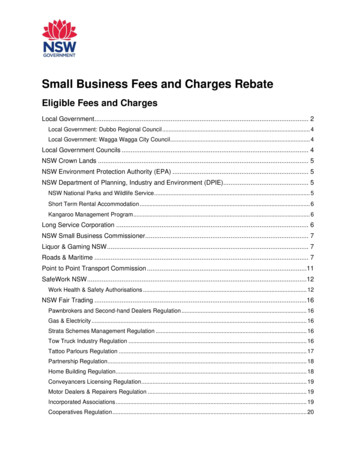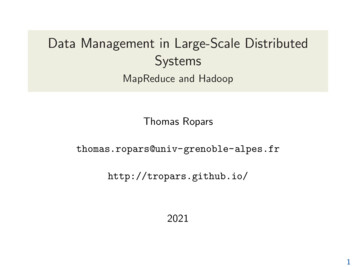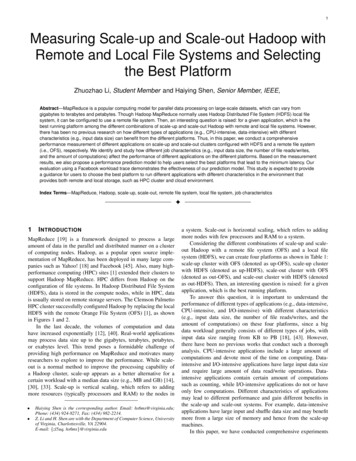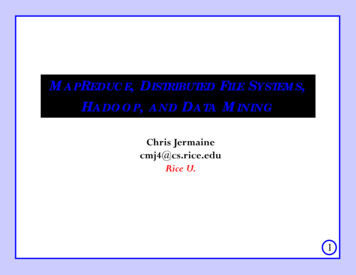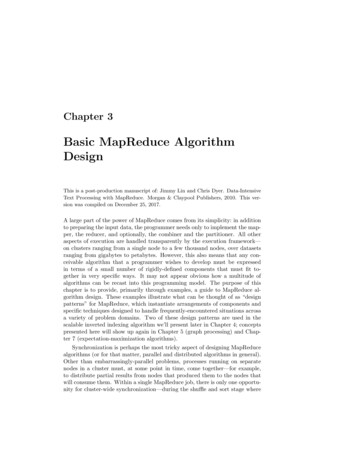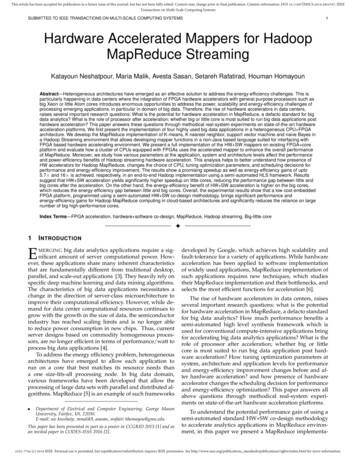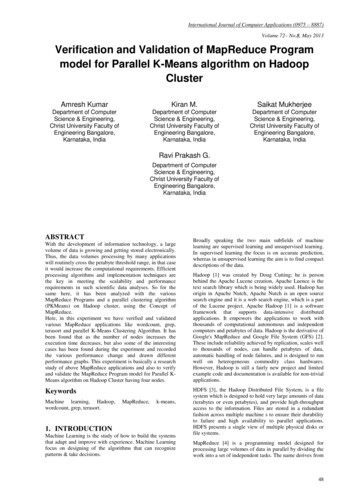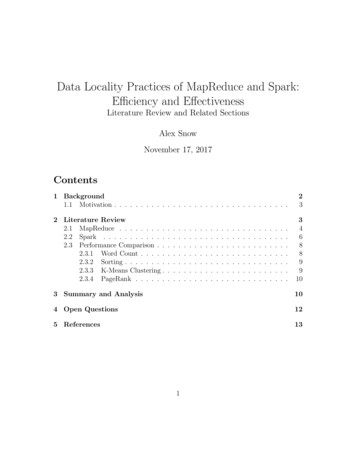
Transcription
Data Locality Practices of MapReduce and Spark:Efficiency and EffectivenessLiterature Review and Related SectionsAlex SnowNovember 17, 2017Contents1 Background1.1 Motivation . . . . . . . . . . . . . . . . . . . . . . . . . . . . . . . . .2 Literature Review2.1 MapReduce . . . . . . . . .2.2 Spark . . . . . . . . . . . .2.3 Performance Comparison . .2.3.1 Word Count . . . . .2.3.2 Sorting . . . . . . . .2.3.3 K-Means Clustering .2.3.4 PageRank . . . . . .233468899103 Summary and Analysis104 Open Questions125 References131
1BackgroundAs data records made the transition from physical to digital, computer scientistssought to process large amounts of data to perform simple and complicated analysison it. Apache Hadoop is an open-source software framework created for handling this”big data”, officially released in 2011. Hadoop’s software library includes HadoopDistributed File System (HDFS), its data storage module, Hadoop YARN, its jobscheduling and resource management module, and Hadoop MapReduce, its data processing module. In particular, MapReduce adapts sequential algorithms to run inparallel over large computer clusters, which can vastly improve runtime. MapReduce requires a partitioned dataset as input so that each piece of the dataset can beassigned to individual worker nodes, which execute map or reduce operations andreport to the master node [W17].MapReduce provides fault-tolerance, or the ability to recover lost data in the eventof machine failure and scalability, but struggles with iterative computation, excessiverecomputation, and high communication costs between nodes. Many of these problems stem from the protocol MapReduce follows for storing input data in relation tothe computation unit, otherwise known as data locality practices. In light of theseflaws, computer scientists strove to create alternatives to MapReduce that would address its weaknesses while still maintaining its strengths. The popular alternative isSpark, an open-source cluster computing framework created by UC Berkeley’s AMPLab. Spark’s developers in an early paper claim that their framework runs iterativejobs up to 10 times faster than MapReduce, yet still retains a similar level of faulttolerance and scalability. They place most of the credit with their special read-onlydataset type, called Resilient Distributed Datasets or RDDs for short. RDDs arecreated and divided between multiple machines and have a unique built-in lost datarecovery system which provides fault-tolerance. RDDs allow Spark to also enjoygreater data locality, where input data is stored very close to the computation unitto reduce computation, because they can be saved in a computer’s main physicalmemory or RAM. Spark was also built around Apache Mesos, a cluster managementproject that also serves as the base for MapReduce. As such, Spark can be used as amodule of Hadoop, and is often packaged with MapReduce in the Hadoop softwaresuite [ZCF10].2
1.1MotivationSeeing as how many of MapReduce’s and Spark’s strengths and weaknesses originate from how they handle data locality, understanding that process would provefruitful for any programmer. From compilers to small scripts, the fundamentals ofdata locality are universal, but how to apply the concepts is dependent upon theprogramming language and architecture [KM92].In the age of ”big data”, its also understandable to want to process data as efficientlyas possible. Spark and MapReduce enable data analysis to be done in parallel withessential fault-tolerance packaged behind a simple API. This accessibility and convenience is a main reason why the two cluster computing frameworks have become sopopular [SQM 15]. From the perspective of an individual not knowledgeable on thesubject, distributing both cluster computing frameworks together in Hadoop seemsredundant, given AMPLab’s claims. However, there do exist cases where MapReduceoutperforms Spark. These performance differences between Spark and MapReducestem mainly from differing approaches to data locality.2Literature ReviewThe literature review will address which data locality design and other design decisions give rise to Spark and MapReduces respective strengths and weaknesses. Itwill also present brief performance comparisons between the two cluster computingframeworks to show how their characteristics impact performance when executingvarious algorithms.3
2.1MapReduceFigure 1: MapReduce ExecutionBefore executing a task, MapReduce first partitions the input data, copies themtwice, and sends the data to HDFS to be saved. HDFS stores data it receives in thebuffer cache or the hard disk, depending upon whether the data will fit in the buffercache or not. The partitions are then distributed amongst the worker nodes, whichapply the specified map function, then yield intermediate results. Next, the masternode sorts the intermediate results by key and per user’s request, combine the datato reduce communication costs between nodes and HDFS. The nodes then hand allrestructured data to HDFS to save in preparation for the reduce stage. After beingassigned a reduce task, the worker nodes read the intermediate data, pulling its partition from either the buffer cache or disk via shuffling. Following which, the nodestry to further minimize computation costs by externally merge-sorting the intermediate data by the intermediate keys before applying the reduce function. Later, theworker nodes run and complete their reduce tasks, which prompts the master nodeto triplicate the final results and store them using HDFS [LLC 11]. Worker nodescontinually notify the master node if they are executing a task. If an assigned node4
fails to communicate with the master node after a certain amount of time, it signifiesmachine failure. Following which, the master node hands the failed task to anotheravailable worker node and a copy of the task’s input data is read from HDFS [DG08].MapReduce’s method of triplicating data at every section of execution guaranteesquality fault-tolerance [LLC 11]. The constant checkpointing and simple scheduleralso ensure improved scalability over other systems [LLC 11]. On the other hand,MapReduce does struggle with a few drawbacks because of its overall design and implementation. For example, MapReduce was designed with acyclic data flow in mind,as each task it runs must read the entirety of the input data before processing it. Assuch, the processing module struggles with iterative computation, which is centeredaround accessing and reusing previously read data [ZCF10]. MapReduce, as seen infigure 1, saves all intermediate and final results using HDFS, which stores the datain either the buffer cache or disk depending on the size of data for fault-tolerancepurposes. However, since the framework cannot reuse output results, many copiesof the same intermediate results are computed and saved by various worker nodes.Consequently, MapReduce suffers from excessive recomputation [DN14]. MapReduce, along with other cluster computing frameworks, sometimes assign tasks thata single node cannot handle within a certain time frame alone to multiple nodes.The downside to this decision is that running a task on multiple nodes requires communication between task fragments, replication of data and aggregation of outputresults [CGB 06]. In turn, the cost of communication between nodes significantlyincreases. This protocol along with others is why MapReduce receives its other significant criticism, its communication costs.Parallel computing frameworks need a methodology of choosing when to store andprocess data with the framework’s set of nodes. This methodology, known as jobscheduling, plays a main role in communication costs in the system and efficiency ofa parallel computing framework. MapReduce uses the Hadoop FIFO (first-in, firstout) scheduling algorithm by default, denoted as dl sched, which focuses solelyon good data locality, but forgoes system load and fairness. The algorithm takesadvantage of the ability of the framework’s nodes to handle both computation andstorage, and strives to achieve ”node-level” data locality, where worker nodes areassigned tasks that process input data the node already contains. If this cannot bedone, the algorithm then tries to assign worker nodes jobs whose input data is on thesame rack as that worker node to achieve ”rack-level” data locality. In the event thatrack-level data locality isn’t feasible either, tasks are randomly assigned to workernodes [GFZ12].5
Common intuition dictates that the overall data locality of MapReduce using dl sched should improve proportionally with the number of nodes, but the relationshipbetween data locality and number of nodes is not linear. Users can set the maximumnumber of tasks a single worker node can be assigned at any one time by settinga certain number of ”task slots”. As such, overall data locality improves proportional to the number of task slots each node has. However, data locality worsensproportional to the number of tasks yet to be done. Therefore, the total number oftask slots should ideally be greater than the number of tasks to be done at all times[GFZ12].2.2SparkFigure 2: Spark ExecutionThe steps Spark takes to execute a task is quite similar to MapReduce’s process. The key changes lie in how the two cluster computing frameworks manipulatethe input data and where they store the data. Spark partitions the input data and6
converts it into RDDs. Next, Spark saves the RDDs in memory, then in the buffercache, then on disk if necessary and runs the same map stage and reduce stage asMapReduce, without the triplication of results.Spark’s central and most touted accomplishment is impressive performance executingiterative jobs, much faster than its predecessors. The key to their success, RDDs, arerecomputed after each use if a cluster has enough memory to accommodate [ZCF10].When there isn’t enough space to store all RDDs into the buffer cache or memory,Spark saves the remaining data on disk, similarly to MapReduce [ZCD Aug12]. Thisway, Spark attains good data locality on most partitions of its input data as opposedto great data locality for a few partitions and poor data locality for others [ZCF10].The developers of Spark advertised the framework as having competent fault-tolerance,which is handled also through RDDs. Spark represents RDDs with five key piecesof information to differentiate one from another: its set of partitions, its set of parent RDD dependencies in the form of pointers to the parent and its transformationinfo, the transformation function used to compute itself, its partitioning strategy,and its data locality directives. Dependencies are classified as either narrow or widedependencies. Narrow dependencies refer to partitions of the parent RDD used byonly one partition of the child RDD. Wide dependencies on the other hand definepartitions of the parent RDD used and shared by multiple RDD partition children.Narrow dependencies enable single cluster nodes to compute new RDD partitions,whereas wide dependencies require more nodes and overhead since pointers to beshuffled around between the nodes [ZCD Apr12]. In the event that a computercrashes during a certain iteration of a job, Spark will use the pointers in the transformation function to recreate the lost RDD instead of recalculating the data fromscratch [ZCD Aug12]. As such, these transformations are lazy operations, operations executed only when necessary [ZCD Apr12].The developers claimed the fault-tolerance found in Spark rivals MapReduce, however this isn’t always the case. The types of dependencies present in a lineage ofRDDs directly influences the performance of Spark’s fault-tolerance system. Recovering lost RDDs becomes increasingly more arduous if the RDD lineage involvedcontained many wide dependencies. In such a case, an RDD’s transformation infomust be passed to all affected nodes for recomputation in the event of machine failureand data loss [ZCD Apr12]. This extra overhead hinders the system’s performance,making it slower than MapReduce’s fault-tolerance system in some situations. Forexample, when reduce tasks are unexpectedly ended, Spark suffers a much greater7
slowdown in comparison to MapReduce. MapReduce only needs to re-execute thetasks, whereas Spark must re-execute the portion of map tasks which lost the blockinformation pertaining to those lost reduce tasks. In addition, when tasks are unexpectedly killed during later iterations of a job, Spark’s toted iterative algorithmperformance suffers a sizeable hit from the RDD lineage system’s extra overhead.All input objects must be completely parsed and initialized as RDDs again to findthe lost RDD’s parent transformation info to recreate the lost data, effectively reexecuting the entire algorithm [SQM 15].The job scheduling algorithm used in Spark assigns and executes jobs in a FIFOorder similar to dl sched. However, Spark’s algorithm categorizes tasks into eitherthe map or reduce phase before assigning them to nodes. The algorithm gives resource priority to all map phase tasks until every single one finishes, after which, thereduce phase tasks gain priority. Newer versions of Spark also contain a more fairscheduling algorithm, which distributes resources evenly amongst all tasks running.There is an option to implement a user-defined scheduling algorithm as well [JS17].2.3Performance ComparisonJuwei Shi et al. in [SQM 15] run performance tests on both MapReduce and Spark,comparing their executions of various algorithms. These performance comparisonsfocus on the architectural differences between Spark and MapReduce to illuminateeach framework’s strengths and weaknesses. In particular, the frameworks’ shufflecomponent, execution model component, and caching component is examined closely.The shuffle component combines, sorts, and aggregates data, and majorly affects thescalability of any framework. The execution model component compiles executionplans from user-defined algorithms, and has a considerable amount of control overthe resource management of a framework. The caching component saves intermediate data locally to be reused across the entire execution of an algorithm, and is acontributing factor to the overhead required to transfer data [SQM 15].2.3.1Word CountA test is run comparing executions of Word Count, a simple algorithm that tallies thenumber of times each unique word appears in a string. For small and large datasets,Spark performs about 3x faster than MapReduce.Spark outperforms MapReduce during the map stage due to its more efficient aggregation component. The component initializes tasks, reads input data, finishes map8
operations, and combines data faster than MapReduce’s aggregation component.Spark utilizes a hash-based combine method while MapReduce opts for a sort-basedcombine method, and in this test, the hash-based method handily defeats the sortbased method. On the other hand, Spark and MapReduce perform the reduce stagesimilarly and as such, have similar execution times.2.3.2SortingJuwei Shi et al. run another test comparing executions of sorting algorithms on arandomly generated dataset from gensort [GDG11]. MapReduce uses a TeraSortalgorithm and Spark uses its built-in function, sortByKey(). Spark runs faster thanMapReduce for small datasets of around 1 GB, but MapReduce surpasses Spark forlarger datasets finishing around 1.8x faster than its competitor.Spark outperforms MapReduce during the map stage thanks to its ability to rereadthe input via the OS buffer cache. As mentioned previously, MapReduce cannotreread data so it falls behind in this regard. Spark also utilizes a hash-based shufflewriter to save the map stage’s results directly to disk as opposed to MapReduce,which collects the results in a side buffer before saving it to the disk. MapReducehowever answers back in spades during the reduce stage, where it finishes the stagefaster than Spark because MapReduce performs part of its map stage during theshuffle stage, thereby mitigating network overhead. Spark’s shuffle and map stageunfortunately do not overlap. In addition, increasing the buffer size for Spark alsoincreases the overhead for garbage collection and page swapping in the OS buffercache, whereas an increase to the buffer size doesn’t adversely affect MapReduce’sperformance.2.3.3K-Means ClusteringMoving into iterative algorithms, Juwei Shi et al. try running similar executionsof K-Means algorithms and analyze the results. K-Means Clustering is a clusteringalgorithm that classifies the data points of a dataset by iteratively defining centersof clusters, and categorizes a point as part of a cluster that it’s closest to. Whentesting the frameworks on a K-Means algorithm, Spark handily beats MapReducein terms of speed and efficiency. In particular, Spark runs 1.5x faster on the firstiteration, and 5x faster on subsequent iterations.During the map stage, Spark vastly outperforms MapReduce thanks to RDD caching.By rereading the input data from memory each iteration, Spark avoids a consider9
able amount of disk overhead MapReduce has to handle. For the reduce stage, eventhough MapReduce must execute additional disk overhead, it performs similarly toSpark due to the test’s low shuffle selectivity.2.3.4PageRankFinally a comparison is done between MapReduce and Spark executing PageRank onFacebook and Twitter datasets, which contain millions of vertices and directed edges.PageRank is a graph algorithm that produces a ranking hierarchy of input elementsbased on the number and quality of links. Since PageRank is also an iterativealgorithm, performance results of MapReduce and Spark were similar to the testsusing K-Means clustering: Spark finishes execution much faster than MapReducedue to RDD caching.3Summary and AnalysisAs seen in various evaluative papers and performance tests, Hadoop MapReducehas an equal distribution of strengths and weaknesses. MapReduce provides greatfault-tolerance through its triplication of all results saved via HDFS. MapReduce alsoenjoys solid scalability thanks to its checkpointing and simple, static evaluation jobscheduling algorithm dl sched. However, the framework cannot reuse input data,resulting in poor performance executing iterative algorithms. As a consequence ofensuring good fault-tolerance and failing to reuse data, MapReduce also struggleswith superfluous recomputation and costly communication between nodes.MapReduce proved to be the cluster computing framework standard, as its advantages and drawbacks shaped development of the cluster computing field for years.By nature, computer scientists sought to improve and optimize MapReduce afterrecognizing its weaknesses. For example, Twister, HaLoop, and Spark are clustercomputing frameworks created as alternatives to MapReduce whose biggest strengthis MapReduce’s greatest weakness: iterative computation [W17]. Whereas Twisterand HaLoop give up some of MapReduce’s advantages for iterative computation performance, the developers of Spark, the AMPLab at UC Berkeley, claimed that theirframework executes iterative algorithms around ten times faster than MapReducewhile still maintaining the fault-tolerance and scalability MapReduce is known for.They manage to achieve these feats through RDDs, which can be stored in memoryand utilize a unique pointer-lineage system to recover lost partitions. With a newfierce competitor on the horizon, a new duality was formed in the cluster computing10
field: one between MapReduce and Spark.I discovered that Spark doesn’t always outperform MapReduce, as shown in theperformance tests in [SQM 15]. In particular, MapReduce finished the sorting testalmost twice as fast as Spark because of Spark’s reliance on the OS buffer cacheto reuse input data. Furthermore, Spark was developed in Scala, a programminglanguage considerably less popular than Java, the language MapReduce was createdwith. Spark also allows users to configure and customize the module to a higher degree compared to MapReduce, with its pre-packaged job scheduling and data localitydesign options [JS17].In regards to data locality, data is optimally saved in the CPU registers, followedby the CPU cache, main physical memory, buffer cache, disk, and then remote disk.Considering that data storage spaces shrink as one moves closer and closer to theCPU, the CPU registers can hold less data than the CPU cache, which hold lessthan RAM, etc. Both MapReduce and Spark try to use the buffer cache then thehard disk to save data. However, before resorting to those locations, Spark triesto store its RDDs in memory, which is closer to the CPU and thus less computationally expensive to use. As such, Spark generally spends less time accessing andsaving data than MapReduce does if Spark manages to write a sizable portion of datain memory. This along with MapReduce’s inability to reread data and data triplication is the key to Spark’s supremacy over MapReduce running iterative algorithms.Consequently, I believe the performance bottleneck of Hadoop MapReduce is itsuse of HDFS. MapReduce’s fault-tolerance system becomes its most computationally taxing set of operations in iterative algorithms because HDFS writes to eitherbuffer cache or disk. If HDFS stored data in the CPU cache or RAM however, thedata triplication required for the fault-tolerance system wouldn’t impact MapReduce’s performance as much. In addition, I believe the performance bottleneck ofSpark is ironically its fault-tolerance system. In the event that a computer in thecluster crashes holding RDD wide dependencies, Spark suffers a major slowdownregenerating the dependency and redistributing the parent information to the dependents. As such, under ideal conditions (few/no machine failures, large memorypool, etc.), Spark will generally outperform MapReduce for most algorithms.11
4Open QuestionsOne topic of interest to be researched further stems from dl sched and its impact on both MapReduce’s performnace. Some evidence shown in [GFZ12] indicatesdl sched may not be optimal, especially during situations where the total numberof task slots equals the number of tasks to be done. The algorithm also schedulestasks with an isolated purview, seeing only the available worker node and the set oftasks that still need to be completed, not the overall landscape of the worker nodes’availability. As an alternative, Guo, Fox, and Zhou in [GFZ12] suggest a schedulingalgorithm that schedules all tasks at once as opposed to dl sched0 s FIFO approach.It would run a linear sum minimization on a matrix of assignment costs, where a lowcost would equate to good data locality and inversely a high cost would equate topoor data locality. I wonder how MapReduce would stack up to Spark through thediscussed performance tests given a new, optimal scheduling algorithm.Another avenue of research to pursue further would be to expand the performancetests between MapReduce and Spark, comparing runs of Multidimensional scaling algorithms and SNP Genotyping with varying dataset sizes. Multidimensional scalingrefers to an iterative, dimensionality reduction process where input data in a certaindimensional space is transposed into a lower dimensional space such that the distancebetween elements of the data is represented as accurately as possible. Data scientistsoften scale down distance matrices to visualize the data. SNP Genotyping is anothercomputationally intensive batch job where single nucleotide polymorphisms (SNPs)in a strand of DNA are compared to a reference genome and labeled accordingly[W17]. Geneticists commonly use this process to check for genetic variations between members of an arbitrary but particular species. Adding another iterative testand acyclic data flow test to the performance comparison narrative would reinforceand cement Spark and MapReduce’s role in the cluster computing field.One other place to take the topic would be to draw conclusions juxtaposing HadoopMapReduce and Spark with MapReduce and Spark utilizing a different softwaresuite or no suite at all. In recent years, Apache, the software company responsiblefor developing the Hadoop suite, has moved their resources away from developingHadoop further and into developing more powerful and less disk-dependent tools toapply map and reduce functions to datasets. This initiative falls in line with theremote, cloud-oriented path technology is currently walking down. Apache’s latestproject, titled Mahout, is an open source software library containing various scalabledata mining and machine learning algorithms implemented with the MapReduce12
paradigm in mind. Many of the algorithms require no Hadoop dependencies whatsoever, so contrasting executions of Hadoop-dependent and not Hadoop-dependentimplementations of the same algorithm could prove insightful towards the efficiencyof Hadoop itself [SO12].5References(CGB 06) Fan Chung, Ronald Graham, Ranjita Bhagwan, Stefan Savage, and Geoffrey M.Voelker. Maximizing data locality in distributed systems. Journal of Computerand System Sciences, vol. 72, no. 8, pp. 1309-1316, Dec. 2006.(DG08) Jeffrey Dean and Sanjay Ghemawat. MapReduce: Simplified Data Processingon Large Clusters. Communications of the ACM - 50th anniversary issue: 1958- 2008, vol. 51, pp. 107-113, Jan. 2008.(DN14) Christis Doulkeridis, Kjetil Nrvg. A survey of large-scale analytical query processing in MapReduce. The VLDB Journal, vol. 23, pp. 355380, Jun. 2014.(GFZ12) Zhenhua Guo, Geoffrey Fox, Mo Zhou. Investigation of Data Locality inMapReduce. CCGRID ’12 Proceedings of the 2012 12th IEEE/ACM International Symposium on Cluster, Cloud and Grid Computing, pp. 419-426,May 2012.(KM92) Ken Kennedy and Kathryn S. McKinley. Optimizing for Parallelism and DataLocality. ICS ’92 Proceedings of the 6th international conference on Supercomputing, pp. 323-334, Aug. 1992.(LLC 11) Kyong-Ha Lee, Yoon-Joon Lee, Hyunsik Choi, Yon Dohn Chung, and BongkiMoon. Parallel Data Processing with MapReduce: A Survey. ACM SIGMODRecord, vol. 40, no. 4, pp. 1120, Dec. 2011.(SO12) Sebastian Schelter and Sean Owen. Collaborative Filtering with Apache Mahout. Recommender Systems Challenge 2012 in conjunction with the ACMConference on Recommender Systems, 2012.(SQM 15) Juwei Shi, Yunjie Qiu, Umar Farooq Minhas, Limei Jiao, Chen Wang, BertholdReinwald, and Fatma Ozcan. Clash of the Titans: MapReduce vs. Spark forLarge Scale Data Analytics. Proceedings of the VLDB Endowment - Proceedings of the 41st International Conference on Very Large Data Bases, Sept.2015.13
(W17) Daniel Washburn. Performance Competitiveness of MapReduce: Applicationsin Scientific Research. Institutional Scholarship, 2017.(ZCD Aug12) Matei Zaharia, Mosharaf Chowdhury, Tathagata Das, Ankur Dave, Justin Ma,Murphy McCauley, Michael J. Franklin, Scott Shenker, and Ion Stoica. Fastand Interactive Analytics over Hadoop Data with Spark. ;login: The UsenixMagazine, vol. 37, no. 4, Aug. 2012.(ZCD Apr12) Matei Zaharia, Mosharaf Chowdhury, Tathagata Das, Ankur Dave, JustinMa, Murphy McCauley, Michael J. Franklin, Scott Shenker, and Ion Stoica.Resilient Distributed Datasets: A Fault-Tolerant Abstraction for In-MemoryCluster Computing. NSDI’12 Proceedings of the 9th USENIX conference onNetworked Systems Design and Implementation, 25 Apr., 2012.(ZCF10) Matei Zaharia, Mosharaf Chowdhury, Michael J. Franklin, Scott Shenker, andIon Stoica. Spark: Cluster Computing with Working Sets. HotCloud’10 Proceedings of the 2nd USENIX Conference on Hot Topics in Cloud Computing,22 Jun. 2010.(JS17) ”Job Scheduling.” Job Scheduling - Spark 1.3.0 duling.html.(GDG11) ”Gensort Data Generator.” Sort Benchmark Data Generator and Output Validator, 2011, www.ordinal.com/gensort.html. I learned a general explanationof gensort from this source.14
on it. Apache Hadoop is an open-source software framework created for handling this "big data", o cially released in 2011. Hadoop's software library includes Hadoop Distributed File System (HDFS), its data storage module, Hadoop YARN, its job scheduling and resource management module, and Hadoop MapReduce, its data pro-cessing module.
